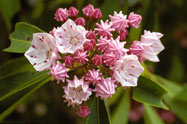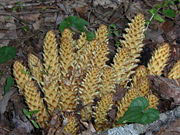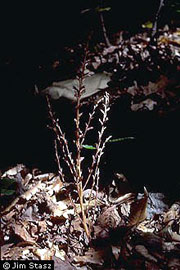TREE TALK
Originally published in Capital on June 6, 2008

From Mountain Laurel to Squaw-Root and Beech Drop
The good, the bad, and the ugly
Right now in the forests of Maryland there are a slew of plants flowering right now. Like everything else there are exceptions as there are some flowers more noticeable than others. At the one end of the extreme, the Mountain laurel (Kalmia latifolia) is in full bloom right now. Common in the understory in many parts of Anne Arundel and across Maryland, Mountain laurel is one of the most attractive flowering plants in the forest. An evergreen shrub with showy flowers formed in clusters, and dark shiny green foliage. An upland species suitable to poor soils and dry sites, the shrub forms dense thickets in the understory of the oak hickory forests that are almost impenetrable. Hence, wildlife are drawn to it for use as cover, and the strong roots systems and density of the stems makes it a very effective stabilizer of soil on steep slopes. A forest with a thick understory of Mountain laurel is a thing to see when it in full bloom.
Mountain laurel is linked directly to the fire ecology of the forest. The waxy coating on the leaves burns like gangbusters, producing large flame fronts that have been estimated to reach 100 feet. After a fire, the Mountain laurel will re-sprout prolifically. And it seems the more intense the fire, the stronger the sprouting response. Since the suppression of all forest fires began in the United States some 80 years ago, these thickets have become more prevalent than thought to exist prior to the advent of aggressive fire suppression. Which is good news for viewing wild flowers, not so good for fire related matters.
 On
the opposite end of the flower spectrum, there is another plant flowering right
now in the oak hickory forests of the Eastern half of the country that is not so
showy and in fact doesn't even look like a flower. At first glance this flower
looks more like a wayward ear of corn or as some have described it as growth
that looks like something you’d go see the doctor about. This plant is called
American cancer-root or squaw-root (Conopholis americana). Squaw-root is
a interesting plant in that it's a true parasite. The plant grows on the roots
of trees, preferably oaks or American beech, and derives all of it's nutrition
from the host plant. The flower resembles an ear of corn, an alternate name for
this plant is 'bear corn'.
On
the opposite end of the flower spectrum, there is another plant flowering right
now in the oak hickory forests of the Eastern half of the country that is not so
showy and in fact doesn't even look like a flower. At first glance this flower
looks more like a wayward ear of corn or as some have described it as growth
that looks like something you’d go see the doctor about. This plant is called
American cancer-root or squaw-root (Conopholis americana). Squaw-root is
a interesting plant in that it's a true parasite. The plant grows on the roots
of trees, preferably oaks or American beech, and derives all of it's nutrition
from the host plant. The flower resembles an ear of corn, an alternate name for
this plant is 'bear corn'.
The plant doesn't have above ground stems, just a spike it produces when flowering, about 8 inches long at most with small scale like leaves that don't have chlorophyll, so they aren’t true leaves. The 'stem' and flowers start out a yellowish color that turns to brown as it ages. The flowers are tubular shaped and are arranged around the spike, producing numerous seeds which is how it spreads. The plant does not appear to harm the host trees, so although it's a parasite, it doesn't threaten the health of the tree in any significant way.
 Another
similar parasitic plant is the Beech Drop (Epifagus virginiana). This
plant is much longer and more slender than the squaw-root and flowers in the
fall. A dullish dark purple in color, this plant is an annual that must reseed
itself each year. As with the squaw-root, the flowers are unremarkable. Beech
drops are found throughout the Eastern United States and will attach itself to
any tree. This plant is more aggressive and will attach itself to one-year-old
seedlings. The plant infects the tree with a root like structure called a
haustorium that enters the host's roots. The beech drop then grows around the
root deriving all of it’s nutrients from the tree.
Another
similar parasitic plant is the Beech Drop (Epifagus virginiana). This
plant is much longer and more slender than the squaw-root and flowers in the
fall. A dullish dark purple in color, this plant is an annual that must reseed
itself each year. As with the squaw-root, the flowers are unremarkable. Beech
drops are found throughout the Eastern United States and will attach itself to
any tree. This plant is more aggressive and will attach itself to one-year-old
seedlings. The plant infects the tree with a root like structure called a
haustorium that enters the host's roots. The beech drop then grows around the
root deriving all of it’s nutrients from the tree.
It is thought that being an annual that has to reseed itself, this probably prevents it from overwhelming and possibly killing the host, which might happen if it attacks a small seedling. The plant was used by the Native Americans as a tea as it had medicinal properties as treatment for dysentery and mouth sores. Apparently it was a rather foul tasting brew, as most medicines seem to be, but effective. The forest has a remarkable and interesting ecology which is exemplified by its diversity and complexity, so there is always something new that's amazing. Go out and enjoy the learning experience.
Questions and comments can be directed to
ForestGreenway@comcast.net
Bud Reaves writes Tree Talk for the Anne Arundel County Forest Conservancy
District Board.
Mountain Laurel (Kalmia latifolia)
Photo by Alan S. Heilman,
University Tennessee Herbarium.
Beech Drop (Epifagus virginiana),
photo courtesy of Jim Stasz